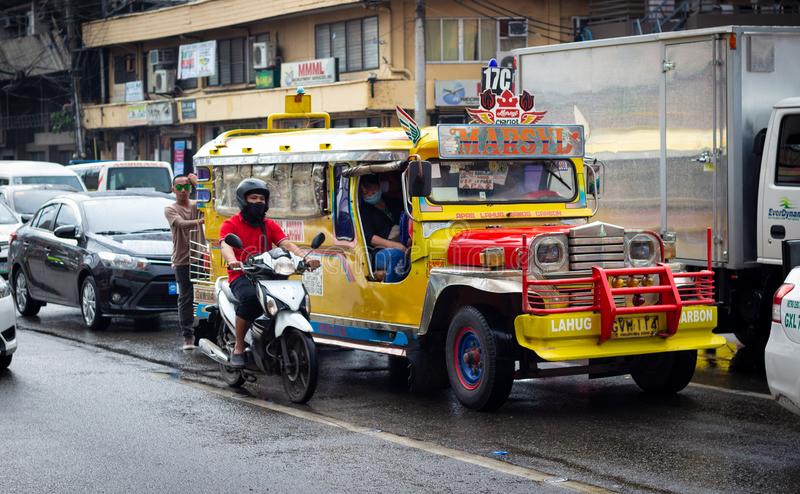A little bit about bechak, jeepney and tuk-tuk
It is worth starting with the fact that the whole of Southeast Asia differs not only ethnically, but also in terms of economic development. This can be felt even within the same country. Hong Kong double-decker buses with a wi-fi network can hardly be classified as exotic. Rather, it is the normal transport of the twenty-first century. High-speed trams, metro and monorails of Bangkok , Kuala Lumpur , Singapore and Hong Kong , too, will not surprise anyone. Is that its cleanliness and coherence of the work of all services. It is much more interesting to move a little away from the main tourist routes and feel the whole local flavor.
Since we started with buses, let’s talk about this transport from different countries. For example, in the Indonesian city of Yogyakarta, you pay for your ride before you get on the bus. The stops are like small pavilions on the podium, equipped with a turnstile. Here it is useless to ask the driver to stop somewhere outside the stop. The entrance doors of the bus are also designed for the height of the podium. At the entrance, you buy a payment card and lower it into the slot of the machine. Now it remains to wait for the bus of your route and go to your destination. In such transport, neither the conductor nor the controller is needed. But there is still a man in uniform at the door. His task is to help everyone and keep order. To the credit of these assistants, they do not formally relate to their duties. At the entrance and exit they will give a hand, help to load and take out things. In general, we are ready to help any passenger as much as possible. But not obsequiously, or in the hope of getting a coin, but simply they do their job well. Having paid once, at the entrance through the turnstile, you can drive around the city. The main thing is not to leave the stop. Change from route to route, and get off where it seems interesting.
Drivers of Sri Lankan buses deserve special words. It is best not to look at the road from behind the driver at first. Perhaps in this country there are some other traffic rules, but they have the same logic. Whoever honks louder and blinks headlights more often has the advantage of passage. Both the driver and the conductor are outstanding characters in Sri Lankan bus transport. If you look at the pedals by the degree of wear, then the brake is used the least. The collection of passengers lies on the conductor. He communicates all the necessary information in loud, jerky tirades. The louder and faster it is said, the more passengers. On the way, the conductor manages to jump out on the move, leave an offering at a roadside temple, pray and catch up with the bus. Without this, it is likely that the trip may not be entirely successful.
In addition to municipal transport, you can use what is characterized by a clear word – minibus. They have different names in different countries. In the Philippines it’s jeepneys, in Thailand it’s songthaews. In Ayutthaya you can find a minibus, which is simply called “seven bat”. In Indonesia , to explain yourself, you can say “public car”. Almost everywhere, local residents will proudly call the final stop of the minibus nothing more than “bus terminal”. And it’s okay that it might just be a roadside at the local market.
Minibuses in Southeast Asia are not much different from each other. Usually, this is a small truck with a makeshift roof and two benches along the sides. Sometimes there are battered buses. But, with normal loading, they are not much different from trucks. Each country has a certain ritual of travel by minibuses. Let’s dwell on this in more detail. Books and studies can be written about this.
Thailand. Thai songthaews are equipped with call buttons in the cabin. All the passengers took their seats, and the minibus set off. Only here you can feel the equanimity of Buddhists. If you’re looking to quickly get from point A to point B on a snogthaew, you can forget about it. It all starts with the first call from the salon. The passenger slowly gets out, bypasses the minibus and stops near the driver’s window. The process of searching for money in the wallet begins. A couple of minutes later, the fare was paid. The minibus moves off, and you sigh with relief that you will finally reach your destination soon. You really rejoice. As soon as the driver makes a regassing, and turns on the second speed, a new call is heard. The exit and payment procedure is repeated with the constancy of Groundhog Day. And no one is outraged that the car drove only fifteen to twenty meters.
Indonesia. Here the ritual of passage depends on the religion of the island. The main religion of this country is Islam. But there are also Christian areas. For example, the Indonesian part of Papua New Guinea is Irianjaya or Sumba Island. In the local minibuses, a relaxed atmosphere reigns. The congestion of transport is determined not by the number of seats, but by the ability of the engine to move everything that is inside and outside the minibus. After the start of the movement, by some miracle, free space appears. Crush and crush are not felt. A friendly Indonesian sitting next to you can treat you to a cigarette and light it himself. A lively conversation ensues in various parts of the salon. One gets the feeling that all these people have known each other for a long time. And if in such a minibus you go to the Baliem valley to the Papuan festival,
Philippines. It is difficult to find another country that would have such a reverent attitude to its transport. We can say that jeepneys are an exclusively Philippine invention. After the Second World War, a lot of automotive equipment remained on abandoned American bases. It was unprofitable to take her away. It was easier to quit. But the Filipinos were smart. Abandoned army trucks and jeeps have made good public transport. To make it more attractive, cars began to be painted in bright colors. A little later, it turned into a real art. Stainless steel elements, additional lighting fixtures, paintings on the sides. Jeepney owners are so fond of their unpretentious cars that a jeepney festival has appeared in the Philippines, where they choose the most beautiful car. It’s safe to say that army equipment successfully coped with its task. Jeepneys have not yet disappeared from the streets of the Philippines and, in the near future, this does not threaten them.
Inside the jeepney along the sides there are two benches. But in order to fully use the volume, additional benches for the central row are added as necessary. There are no call buttons in the cabin; to stop, they simply knock with a coin on the plywood roof. Jeepney conductor does not occupy a separate place. You can constantly see him, looking out the window on the go from the outside, then from one side, then from the other side. In addition to collecting payment, its functions include assistance with boarding and exiting, loading purchases and things of passengers onto the roof, and commands to the driver about stops and permission to move off. Sometimes the driver has to move in the cab to put another passenger on.
In the countries of Southeast Asia, in addition to minibuses, there is also an individual hired passenger transport. In most countries it is called tuk-tuk. And only in the Philippines – tricycle. Usually, it is based on a motorbike. Passenger seats are in additional carts, as in Cambodia, or on a rigid frame attached to the bike, as in Thailand and Indonesia. Each country has its own design. It would be possible to make a separate selection of “Tuk-tuks from different countries.” A tricycle differs from a tuk-tuk in that the driver does not sit in front of the passengers, but next to them. In other words, it is a motorcycle with a sidecar, where the sidecar is made in the form of a cabin. And taxi drivers and tuk-tuk drivers have one thing in common – if they see a tourist, then the first price is usually announced twice as high. This is an international psychology that you encounter in any country.
The strange name “bechak” means an ordinary cycle rickshaw. Such transport can be found in many countries, but only in Indonesia it is called that way. It is becoming increasingly difficult for trishaw drivers to compete with tuk-tuks and motorbikes, so the becak is used more as a tourist transport for sightseeing. It can be driven around the Old Quarter in Hanoi, or Malioboro Street in Yogyakarta, or Intramuros in Manila. Horse-drawn carriages can also be attributed to non-motorized transport. They are often used as recreational vehicles.
In every country you can find something unusual that deserves special attention. Sometimes it is worth giving up air-conditioned cars to get the opportunity to plunge into the flavor of local life.









